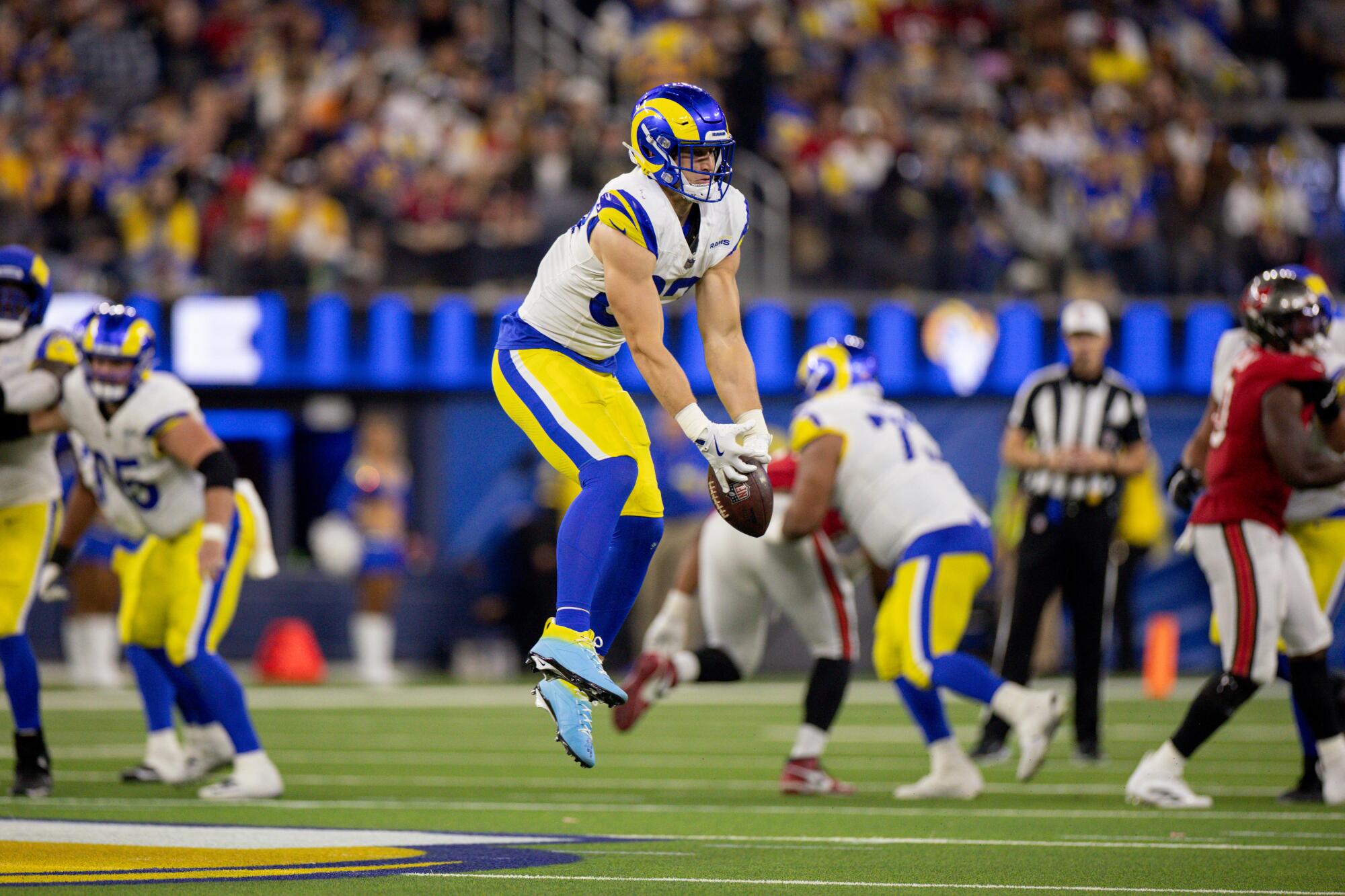Rams surge to top of NFC, blowing out Bucs for 6th straight win
Less than an hour before the Rams and Tampa Bay Buccaneers kicked off on Sunday, fans in SoFi Stadium erupted in cheers.
Watching the giant video board, the crowd celebrated as the Philadelphia Eagles blew a huge lead and lost to the Dallas Cowboys.
That meltdown by the defending Super Bowl champions positioned the surging Rams to move to the top of the NFC.
Quarterback Matthew Stafford continued his MVP-caliber play by passing for three touchdowns, and the defense also produced big moments as the Rams seized the opportunity with a 34-7 victory that extended their winning streak to six games and improved their record to a conference-best 9-2.
That makes the Rams the current No. 1 seed for the NFC playoffs.
There is still a long way to go. And the Eagles hold the tiebreaker over the Rams by virtue of their Week 3 victory at Philadelphia.
But if the Rams maintain sole possession of first place and secure home-field advantage, they would avoid another potential January trip to Lincoln Financial Field to play the Eagles, who eliminated the Rams there in the NFC divisional round last season.
The Rams play at Carolina next week and then at Arizona before returning to SoFi Stadium for another NFC measuring-stick game against the Detroit Lions. The Rams finish the season with a Thursday night game in Seattle, a trip to Atlanta and a home game against the Cardinals.

Rams tight end Davis Allen catches a pass in the second half against the Buccaneers on Sunday.
(Eric Thayer / Los Angeles Times)
So the biggest question facing coach Sean McVay and the Rams: Are they peaking too soon?
Despite being without veteran tight end Tyler Higbee, right tackle Rob Havenstein and safety Quentin Lake — all placed on injured reserve last week — the Rams appeared nearly unstoppable on offense in the first half and dominant on defense throughout.
The Rams scored at least 34 points for the fourth time in five games. Stafford tossed two touchdown passes to Davante Adams and one to tight end Colby Parkinson, increasing his league-leading total to 30, with only two interceptions. Stafford has not had a pass intercepted in eight games.

Rams quarterback Matthew Stafford threw three more touchdown passes Sunday against the Buccaneers, giving him a league-leading 30.
(Eric Thayer/Los Angeles Times)
On Sunday the 17th-year pro completed his first 12 passes for 121 yards and a touchdown before a second-quarter pass fell incomplete. He finished 25 of 35 for 273 yards, the crowd chanting “M-V-P” after each of his last two touchdown passes.
Adams, who had bemoaned his performance in last week’s 21-19 victory over the Seahawks, seemingly was happier after catching five passes for 62 yards and increasing to 12 his league-leading total of touchdown catches.
On a night the Rams honored future Hall of Fame defensive lineman Aaron Donald with a bobblehead giveaway and other tributes, defensive end Kobie Turner and edge rusher Jared Verse each had two sacks. A secondary that intercepted four passes last week picked off two more, cornerback Cobie Durant returning one for a 50-yard touchdown and Emmanuel Forbes Jr. catching a desperation heave on the final play of the first half.

Rams linebackers Jared Verse, left, and Josaiah Stewart, center, and defensive end Kobie Turner celebrate in the first half.
(Eric Thayer / Los Angeles Times)
Rams special teams, which cost the team dearly in losses against the Eagles and the San Francisco 49ers, appear to be operating with efficiency since kicker Harrison Mevis replaced Joshua Karty and veteran Jake McQuaide supplanted Alex Ward as the snapper.
After Mevis kicked only extra points in his first two games, McVay finally gave him field-goal opportunities, and Mevis converted 40- and 52-yard kicks.
The Rams ruined Buccaneers quarterback Baker Mayfield’s return to the stadium where he resurrected his career in 2022 by leading the Rams to a last-second victory over the Las Vegas Raiders with only two days of practice.
Mayfield sustained a left-shoulder injury and did not play in the second half. He completed nine of 19 passes for 41 yards and a touchdown with two interceptions.
It all added up to a convincing victory for the Rams. And here’s a scary thought for the rest of the NFL: The Rams are on track to get stronger down the stretch.
Receiver Tutu Atwell is eligible to return from injured reserve next week. Cornerback Ahkello Witherspoon, who suffered a broken collarbone in the second game of the season, is closer to a return. And McVay said Higbee and Havenstein could be back in four games, and Lake could return for the playoffs.
Those reinforcements would be a desirable situation for any Super Bowl contender in the NFC.
Especially the one currently on top.
